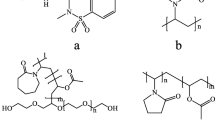Abstract
Ezetimibe (EZE), a water insoluble drug, depicts variable bioavailability. The objective of the present investigation was to improve dissolution characteristics of EZE, which might offer improved bioavailability. The solid dispersions were prepared using poloxamer 407 (L 127) and polyvinyl pyrrolidone by melt and solvent method, respectively. Phase solubility studies indicated linear relationship between drug solubility and carrier concentration. In vitro release studies revealed improvement in the dissolution characteristics of EZE in solid dispersions. Solid dispersion with L 127 gave better rate and extent of dissolution. The best fit model indicating the probable mechanism of drug release from solid dispersions was found to be Korsemeyer–Peppas. The results of characterization of solid dispersions by Fourier transform infrared spectroscopy, differential scanning calorimetry, and powder X-ray diffraction revealed reduction in drug crystallinity which might be responsible for improved dissolution properties. The tablets of solid dispersion, containing L 127 prepared by direct compression, exhibited better drug release as compared to marketed formulation.








Similar content being viewed by others
References
Lipinski CA, Lombardo F, Dominy BW, Feeney PJ. Experimental and computational approaches to estimate solubility and permeability in drug discovery and development settings. Adv Drug Deliv Rev. 2001;46:3–26.
Fahr A, Liu X. Drug delivery strategies for poorly water-soluble drugs. Expert Opin Drug Deliv. 2007;4(4):403–16.
Horter D, Dressman JB. Influence of physicochemical properties on dissolution of drug in the gastrointestinal tract. Adv Drug Deliv Rev. 2001;46:75–87.
Serajuddin ATM. Solid dispersions of poorly water-soluble drugs: early promises, subsequent problems, and recent breakthroughs. J Pharm Sci. 1999;88(10):1058–66.
Leuner C, Dressman J. Improving drug solubility for oral delivery using solid dispersions. Eur J Pharm Biopharm. 2000;50:47–60.
Craig DQM. The mechanism of drug release from solid dispersions in water-soluble polymers. Int J Pharm. 2002;231:131–44.
Kosoglou T, Statkevich P, Johnson-Levonas AO, Paolini JF, Bergman AJ, Alton KB. EZE: a review of its metabolism, pharmacokinetics and drug interactions. Clin Pharmacokinet. 2005;44(5):467–94.
Lipka LJ. EZE: a first-in-class novel cholesterol absorption inhibitor. Cardiovasc Drug Rev. 2003;21(4):293–312.
Dixit RP, Nagasenker MS. Self-nanoemulsifying granules of EZE: design, optimization and evaluation. Eur J Pharm Sci. 2008;35:183–92.
Patel R, Bhimani D, Patel J, Patel D. Solid-state characterization and dissolution properties of EZE–cyclodextrins inclusion complexes. J Incl Phenom Macrocycl Chem. 2008;60:241–51.
Pore YV, Sancheti PP, Karekar P, Vyas VM, Shah M. Preparation and physicochemical characterization of surfactant based solid dispersions of EZE. Pharmazie. 2009;64(4):227–31.
Van den Mooter G, Augustijns P, Blaton N, Kinget R. Physico-chemical characterization of solid dispersions of temazepam with polyethylene glycol 6000 and PVP K30. Int J Pharm. 1998;164:67–80.
El-Badry M, Fathy M. Enhancement of the dissolution and permeation rates of meloxicam by formation of its freeze-dried solid dispersions in polyvinylpyrrolidone K-30. Drug Dev Ind Pharm. 2006;32:141–50.
Shinde VR, Shelake MR, Shetty SS, Chavan-Patil AB, Pore VV, Late SG. Enhanced solubility and dissolution rate of lamotrigine by inclusion complexation and solid dispersion technique. J Pharm Pharmacol. 2008;60:1121–9.
Ruan LP, Yu BY, Fu GM, Zhu DN. Improving the solubility of ampelopsin by solid dispersions and inclusion complexes. J Pharm Biomed Anal. 2005;38:457–64.
Ahuja N, Katare OP, Singh B. Studies on dissolution enhancement and mathematical modeling of drug release of a poorly water-soluble drug using water-soluble carriers. Eur J Pharm Biopharm. 2007;65:26–38.
Yamamoto K, Chutimaworapan S, Ritthidej GC, Yonemochi E, Oguchi T. Effect of water soluble carriers on dissolution characteristics of nifedipine solid dispersions. Drug Dev Ind Pharm. 2000;26(11):1141–50.
Kalaiselvan R, Mohanta GP, Manna PK, Manavalan R. Studies on mechanism of enhanced dissolution of albendazole solid dispersions with crystalline carriers. Indian J Pharm Sci. 2006;68(5):599–607.
Higuchi T, Connors KA. Phase solubility techniques. Adv Anal Chem Instrum. 1965;4:117–212.
USFDA, Available at http://www.accessdata.fda.gov/scripts/cder/dissolution/dsp_SearchResults_Dissolutions.cfm, Accessed on December 16, 2008.
Patel RP, Patel MM. Physicochemical characterization and dissolution study of solid dispersions of lovastatin with polyethylene glycol 4000 and polyvinylpyrrolidone K30. Pharm Dev Technol. 2007;12:21–33.
Devane J, Butler J, Dunne A, O’Hara T. A review of methods used to compare dissolution profile data. Pharm Sci Technol Today. 1998;1(5):214–23.
Fernandes CM, Vieira MT, Veiga JB. Physicochemical characterization and in vitro dissolution behavior of nicardipine–cyclodextrins inclusion compounds. Eur J Pham Sci. 2002;15:79–88.
Tantishaiyakul V, Kaewnoparrat N, Ingakatawornwong S. Properties of solid dispersions of piroxicam in polyvinypyrollidone-K30. Int J Pharm. 1996;143:59–66.
Yamashita K, Nakate T, Okimoto K, Ohike A, Tokunaga Y, Ibuki R, et al. Establishment of new preparation method for solid dispersion formulation of tacrolimus. Int J Pharm. 2003;267:79–91.
Costa P, Lobo JMS. Modeling and comparison of dissolution profiles. Eur J Pharm Sci. 2001;13:123–33.
Ali W, Williams AC, Rawlinson CF. Stochiometrically governed molecular interactions in drug: poloxamer solid dispersions. Int J Pharm. 2010;391:162–8.
Acknowledgments
The authors are thankful to Mepro Pharmaceuticals Ltd. (Surendranagar, India) and BASF Ltd. (Mumbai, India) for providing EZE and L 127, respectively, as gift samples.
Author information
Authors and Affiliations
Corresponding author
Rights and permissions
About this article
Cite this article
Parmar, K.R., Shah, S.R. & Sheth, N.R. Preparation, Characterization, and In Vitro Evaluation of Ezetimibe Binary Solid Dispersions with Poloxamer 407 and PVP K30. J Pharm Innov 6, 107–114 (2011). https://doi.org/10.1007/s12247-011-9104-8
Published:
Issue Date:
DOI: https://doi.org/10.1007/s12247-011-9104-8




